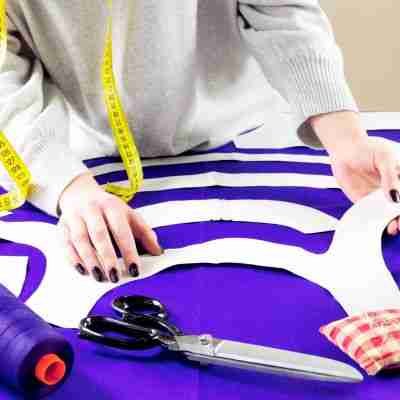Sewing is a creative and rewarding hobby that allows you to make your own unique clothing and accessories.

It does not matter if you’re a complete beginner or have some sewing experience, using sewing patterns is essential to creating well-fitted and professional-looking garments.
In this article, we will explore the world of free sewing patterns for beginners and provide a guide on how to read and understand them.
Introduction to Sewing Patterns
Sewing patterns are templates that provide step-by-step instructions for creating garments or other fabric items. They include a range of information, from measurements and fabric requirements to cutting layouts and assembly instructions. Patterns are available for various skill levels, making them an excellent resource for beginners who are just starting their sewing journey.
Sewing is a great hobby to get into and a great way to create custom garments and accessories. There are lots of free sewing patterns for beginners available online. Here are a few sites to get you started:
- Craftsy – Craftsy has a great selection of free sewing patterns for beginners, including everything from tops and skirts to home décor and accessories.
- AllFreeSewing – AllFreeSewing has hundreds of free sewing patterns for every skill level. They also have great tutorials and guides to help you learn how to read and interpret a sewing pattern.
- So Sew Easy – So Sew Easy has lots of free patterns for beginner sewists, including clothing, bags, and quilts. They also have helpful tutorials to explain the different parts of a sewing pattern.
HOW TO READ FREE SEWING PATTERNS
Reading sewing patterns can seem daunting to the inexperienced, but with the right guidance it can be an enjoyable and rewarding experience.
To start, it’s important to understand the various elements of a pattern, such as the fabric requirements, notches, and seam allowances.
Once you’ve familiarized yourself with the pattern, make sure to read through the instructions very carefully
– don’t rush!
It’s also a good idea to mark any important details on the pattern, such as measurements, so that you don’t lose track of them.
When cutting out the pieces, make sure to use sharp scissors and to use the pattern markings as a reference.
Finally, when stitching the pieces together, always double check that you’re following the instructions correctly.
By taking your time and following the instructions carefully, you will be able to successfully complete the sewing project.
SEWING PATTERNS FOR BEGINNERS
If you’re looking for sewing patterns for beginners, there are lots of great options out there. Here are a few to get you started:
- BurdaStyle: This website offers a variety of beginner-friendly sewing patterns for all types of garments, from dresses to blouses to skirts and more.
- Sewing.org: This website is a great resource for all levels of sewers, and it has lots of beginner-friendly patterns to choose from.
- Craftsy: Craftsy has a wide selection of pattern designs and tutorials for beginners.
- AllFreeSewing: This website is perfect for beginners, as it offers a range of patterns from simple to complex.
I hope this helps you get started on your sewing journey!
Good luck and have fun!
DRESS FREE SEWING PATTERNS FOR BEGINNERS
If you’re just getting started with sewing and are looking for a fun project, a dress sewing pattern is a great place to start! There are a variety of free sewing patterns available for beginners, ranging from simple A-line dresses to more complex designs. To help you choose the right pattern, consider the following points:
- Fabric type: Not all fabrics are suitable for dressmaking, so it’s important to choose the right fabric for the project. For beginners, cotton is a great choice as it’s easy to work with and comfortable to wear.
- Skill level: Look for patterns that are suitable for your skill level. Many patterns will list the skill level required, from beginner to advanced. Start with something simple and work your way up.
- Size: Make sure you choose a pattern that is the right size for you. Most patterns will include instructions for resizing, but if you’re new to sewing, it’s best to stick with the size listed on the pattern.
- Instructions: Look for patterns that have detailed instructions and illustrations. This will make it easier to follow the pattern and help you to create a beautiful garment.
Once you’ve found the perfect pattern, you can get started on your dress! With patience and practice, you’ll soon be creating beautiful garments that you can be proud of.
RELEVANT YOUTUBE VIDEOS
FREE SEWING PATTERNS TO DOWNLOAD
There are some great sites for free sewing patterns to download. I would recommend checking out the following websites for some great free tutorials and patterns:
- Craftsy: https://www.craftsy.com/sewing/
- All Free Sewing: https://www.allfreesewing.com/
- Sewing.org: https://sewing.org/free-patterns/
- So Sew Easy: https://so-sew-easy.com/free-sewing-patterns/
FREE SEWING PATTERNS FOR CHILDREN DOWNLOAD
Here are a few websites that offer free sewing patterns for kids:
- Craftsy – Craftsy offers free sewing patterns for children’s clothing, stuffed animals, and accessories.
- Sew Different – Sew Different offers free sewing patterns for female clothing and accessories.
- All Free Sewing – All Free Sewing has a wide selection of free sewing patterns for kids, including clothing, accessories, and toys.
TIPS FOR BEGINNERS ON HOW TO TRACE A SEWING PATTERN
If you’re new to sewing, tracing a pattern can seem like a daunting task. However, it’s actually quite straightforward and easy once you get the hang of it. Here are a few tips to get you started:
- Choose the correct paper: You’ll need to choose pattern paper or tracing paper that is lightweight but still stable enough to handle the tracing and cutting process.

- Cut out the pieces: Once you’ve traced the pattern onto the paper, use a pair of sharp fabric scissors to cut out the pieces. Make sure to cut precisely along the lines you traced.
- Label the pieces: To keep your pattern pieces organized, label each piece with a piece number, the fabric type, and the size.
- Transfer markings: If the pattern has any notches, darts, or special markings, use a tracing wheel to transfer them onto the paper pattern pieces.
Tracing a pattern is a great way to get a custom fit for any garment. With a little practice, you’ll be a pro in no time!
Advantages of Using Free Sewing Patterns
Free sewing patterns are an ideal starting point for beginners as they allow you to practice your skills without the financial commitment. These patterns are available online and cover a wide range of styles, from simple tops to more complex dresses. Additionally, they often come with detailed instructions and illustrations, making the learning process easier.
Choosing the Right Pattern for Your Skill Level
As a beginner, it’s essential to select patterns that match your current skill level. Look for patterns labeled as “beginner,” “easy,” or “simple.” These patterns generally involve fewer pieces and straightforward construction techniques, ensuring a smoother sewing experience.
Understanding Pattern Terminology
Sewing patterns use specific terminology that might be confusing for newcomers. Key terms include seam allowance, grainline, notches, and darts. It’s crucial to familiarize yourself with these terms to accurately interpret the instructions.
Decoding Pattern Instructions
Pattern instructions guide you through each step of the sewing process. They include information about cutting the fabric, sewing seams, adding closures, and finishing touches. Take your time to read and understand each instruction before proceeding.
Gathering Materials and Tools
Before starting a sewing project, gather all the necessary materials and tools. This includes fabric, thread, needles, scissors, pins, and a sewing machine. Having everything ready will make the sewing process more efficient.
Taking Accurate Measurements
Accurate measurements are essential for a well-fitting garment. Use a tape measure to measure your bust, waist, hips, and other relevant areas. Refer to the pattern’s size chart to determine the correct size to cut.
Printing and Assembling PDF Patterns
Many free sewing patterns are available as downloadable PDF files. After downloading, print the pattern pieces and assemble them according to the provided instructions. Ensure that the scaling is correct before cutting the fabric.
Cutting and Marking the Fabric
Carefully cut the fabric according to the pattern pieces. Transfer any markings, such as notches and darts, to the fabric using tailor’s chalk or washable markers. These markings are essential for aligning and sewing the pieces accurately.
Pinning and Sewing the Pieces Together
Use pins to secure the fabric pieces together before sewing. Follow the pattern’s sewing sequence to assemble the garment. Use the appropriate stitch settings on your sewing machine and take your time to sew each seam accurately.
Making Necessary Adjustments
Not all bodies are the same, so you might need to make minor adjustments for a perfect fit. Common adjustments include altering the hem length, adjusting the waistline, or adding darts for better shaping.
Adding Zippers, Buttons, and Other Notions
If your pattern includes closures like zippers or buttons, follow the instructions carefully to add them. These closures provide functionality and aesthetics to your finished garment.
Pressing and Finishing Techniques
Pressing your seams and finished garment is crucial for a professional look. Use an iron to press seams open or to one side, and follow the recommended pressing techniques in the pattern instructions.
Troubleshooting Common Pattern Issues
Mistakes can happen, even to experienced sewists. If you encounter an issue, don’t be discouraged. Look for solutions online or ask for advice in sewing communities. Common issues include mismatched seams, puckering fabric, and uneven hems.
Exploring Online Sewing Communities
Joining online sewing communities and forums can be incredibly helpful, especially for beginners. These communities provide a platform to ask questions, share experiences, and gain valuable insights from more experienced sewists.
Conclusion
Embarking on your sewing journey as a beginner can be both exciting and fulfilling. Free sewing patterns offer a fantastic way to hone your skills while creating stylish and personalized garments. Remember to take your time, read instructions carefully, and don’t hesitate to seek help when needed. With practice, you’ll master the art of sewing and create beautiful pieces that you can be proud of.
FAQs
- Are free sewing patterns suitable for complete beginners? Absolutely! Free sewing patterns are designed with beginners in mind and often come with detailed instructions.
- Do I need a sewing machine to use sewing patterns? While hand sewing is possible, a sewing machine will make the process faster and more efficient.
- What if the finished garment doesn’t fit me well? You can make minor adjustments to the garment, such as hemming or taking in the seams, to achieve a better fit.
- Where can I find online sewing communities? Platforms like Reddit, sewing forums, and social media groups are excellent places to connect with other sewists.
- What’s the difference between a PDF pattern and a printed pattern? A PDF pattern is downloaded and printed at home, while a printed pattern is a physical copy that you purchase or receive. Both offer the same instructions and design.





